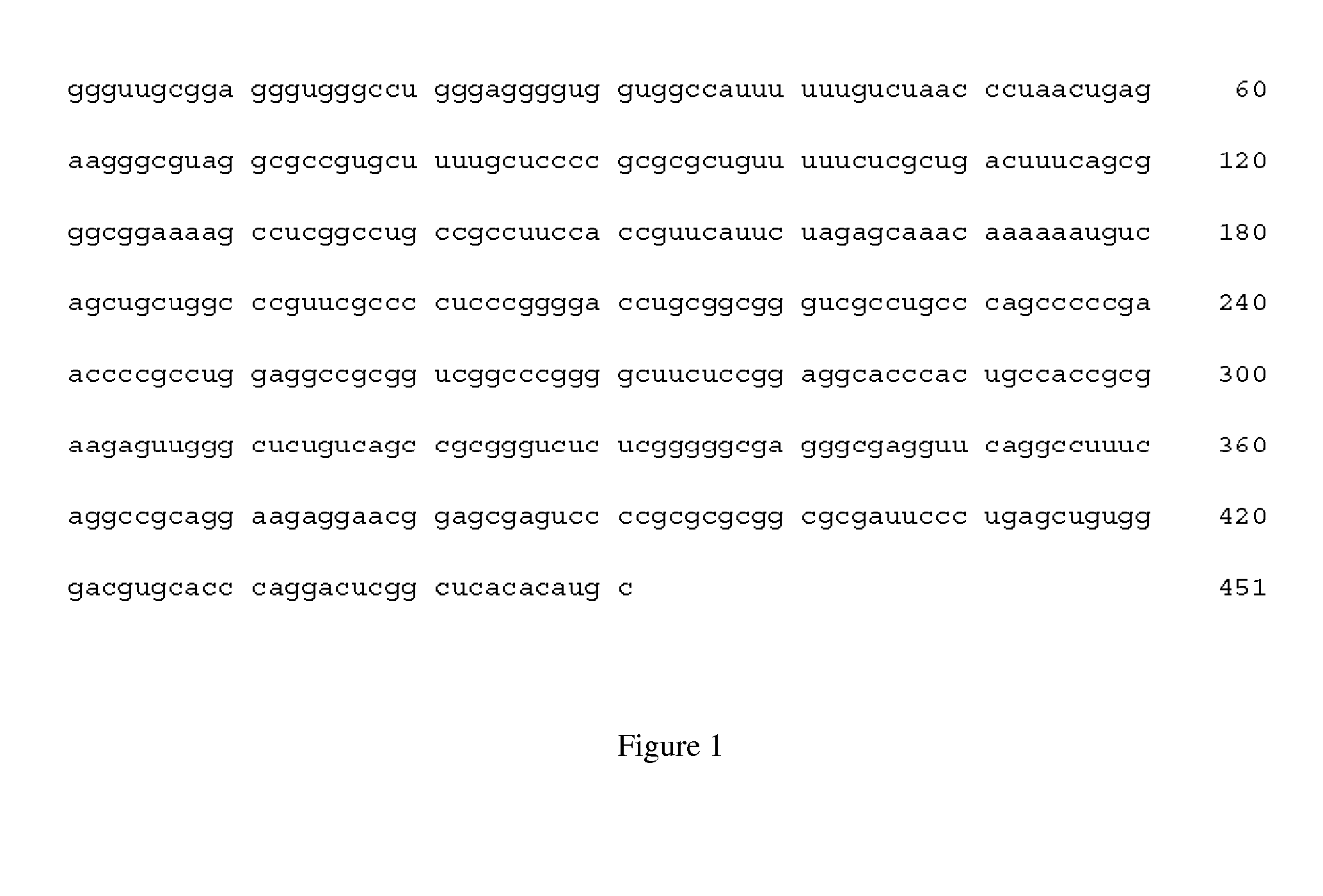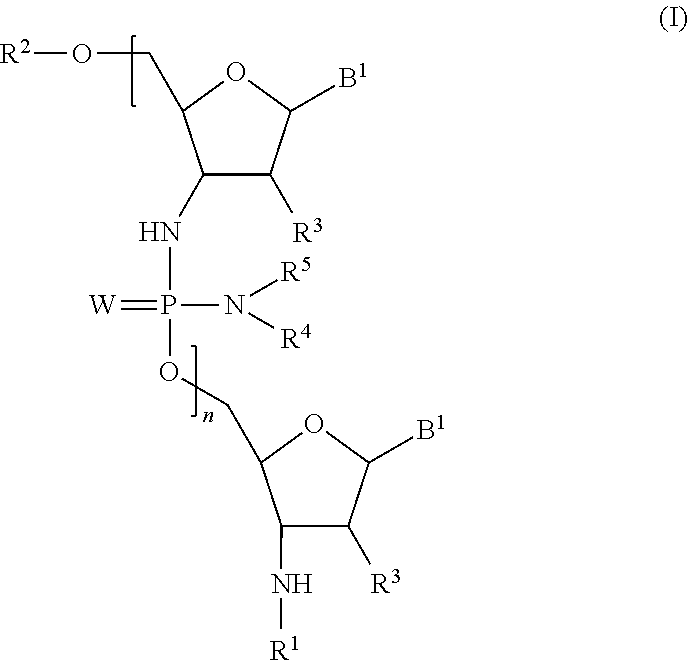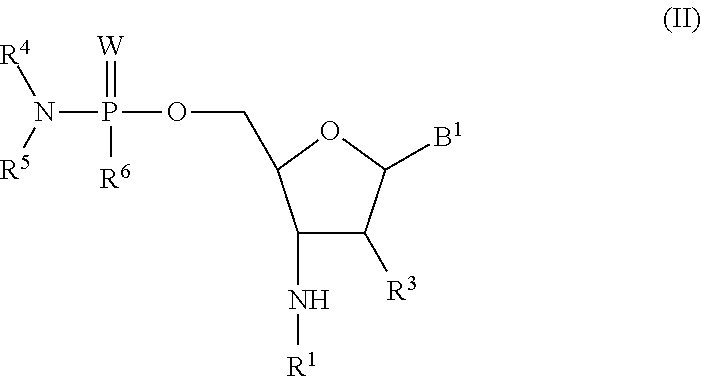Phosphorodiamidate backbone linkage for oligonucleotides
a backbone linkage and oligonucleotide technology, applied in the field of antisense oligonucleotides, can solve the problems of limiting the efficiency of cellular uptake, reducing the stability of the duplex, and cellular uptake is reduced, so as to achieve the effect of effectively targeting and/or inhibiting non-coding rna
- Summary
- Abstract
- Description
- Claims
- Application Information
AI Technical Summary
Benefits of technology
Problems solved by technology
Method used
Image
Examples
example 1
General Procedure for the Synthesis of Dimethylamino-Phosphorochloridate Monomers
[0405]The scheme for synthesizing dimethylamino-phosphorochloridate monomers is shown in the scheme below.
[0406]Seven mmol of the 5′-hydroxyl protected 3′-amino-nucleoside was dissolved in 30-100 ml dry dichloromethane. Fourteen mmol of 2,6-Lutidine and 7 mmol of N-methylimidazole was added and the solution or suspension was cooled to 0° C. Fourteen mmol of dimethylamino-phosphorodichloridate was added dropwise over 5 minutes. The reaction mixture was allowed to warm up to room temperature and stirred for 1-2 hours. The reaction was followed by TLC using dichloromethane / methanol 9:1 solvent system. After the disappearance of the starting material, the reaction mixture was loaded on a silica gel column prepared with chloroform / acetone 95:5. The acetone content was gradually increased to 25%. The two isomers of the product was collected and evaporated in vacuo. The yield of the reaction after chromatograp...
example 2
Synthesis of Dimer on Solid Phase
[0414]The procedure for synthesizing a thymidine-adenosine dimer protected with trityl group is described below.
[0415]The default 1 μmol synthesis cycle on an Applied BioSystems (Foster City, Calif.) DNA synthesizer was modified as follows: the wait for the coupling was set to 60 minutes, the oxidation step was deleted, and after the deblocking step, 5% DIEA solution in dichloromethane from the vessel usually containing the oxidizer was delivered to the column for 5 seconds. The monomer was a 0.2 M solution in dichloromethane. The activator vessel contained 0.6 M solution of diisopropylamino-ethanol. The deblock solution was 5% cyanoacetic acid in dichloromethane containing 10% trifluoroethanol.
[0416]The synthesis column contained approximately 1 μmol 3′-aminotrityl-CPG. The synthesis column was heated with a heating tape to 40° C.
[0417]At the end of the cycle, the dimer was deblocked using ethanol-cc. ammonia 1:2 for 1 hour at 55° C.
[0418]The two is...
example 3
Synthesis of Compound C
[0420]The procedure for synthesizing a thymidine-thymidine dimer protected with trityl group and t-butyl-dimethylsilyl group (Compound C) is described below.
[0421]1.2 g (3.38 mmols, 1.2 eqs) of Compound B was dissolved in a mixture of CH3CN / DCM (15 ml / 10 ml) and 1.2 mL (6.76 mmol, 2.2 eqs) of DIPEA was added to it followed by 1.7 g (2.81 mmol, 1 eq) of Compound A. To this mixture was added 500 mg (6.76 mmol, 2.2 eq.) of LiBr and the reaction mixture stirred for 30 minutes. The TLC showed complete consumption of 1 at which time the solvents were evaporated and the residue was dissolved in dichloromethane and washed with 2×H2O, 1× brine, dried over Na2SO4, filtered and evaporated. Crude yield was 2.7 grams (quant.). The HPLC and the LC-MS trace corresponded to Compound C.
[0422]The HPLC trace for Compound A: Compound A eluted at 13.8 minutes.
[0423]The HPLC trace for crude product eluted at 15.2 and 17.9 minutes
[0424]The HPLC trace for Compound C: Isomers of compo...
PUM
 Login to View More
Login to View More Abstract
Description
Claims
Application Information
 Login to View More
Login to View More - R&D
- Intellectual Property
- Life Sciences
- Materials
- Tech Scout
- Unparalleled Data Quality
- Higher Quality Content
- 60% Fewer Hallucinations
Browse by: Latest US Patents, China's latest patents, Technical Efficacy Thesaurus, Application Domain, Technology Topic, Popular Technical Reports.
© 2025 PatSnap. All rights reserved.Legal|Privacy policy|Modern Slavery Act Transparency Statement|Sitemap|About US| Contact US: help@patsnap.com



